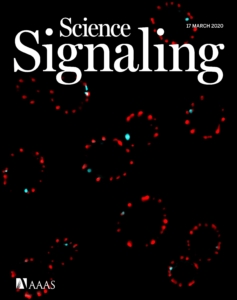
As the physical barrier between the cell and the outside environment, the plasma membrane is well-positioned to be the first responder to stress. The membrane is also highly vulnerable to many types of perturbation, including heat, force, osmotic pressure, lipid shortage, and starvation. To determine whether the structural changes in the plasma membrane of Saccharomyces cerevisiae brought about by nutrient stress can be communicated to regulatory networks within the cell, we identified proteins that interact with stress granules (SGs), subcellular structures composed of proteins, and nontranslated RNAs that form when cells are stressed. We found that SG proteins interacted with components of eisosomes, which are subcortical membrane structures with a distinct lipid and protein composition. In response to starvation-triggered phosphorylation of eisosome proteins, eisosomes clustered and recruited SG components, including active Pkc1. The absence of eisosomes impaired SG formation, resulting in delayed recovery from nutrient deprivation. Thus, eisosome clustering is an example of interdomain communication in response to stress and identifies a previously unknown mechanism of SG regulation.